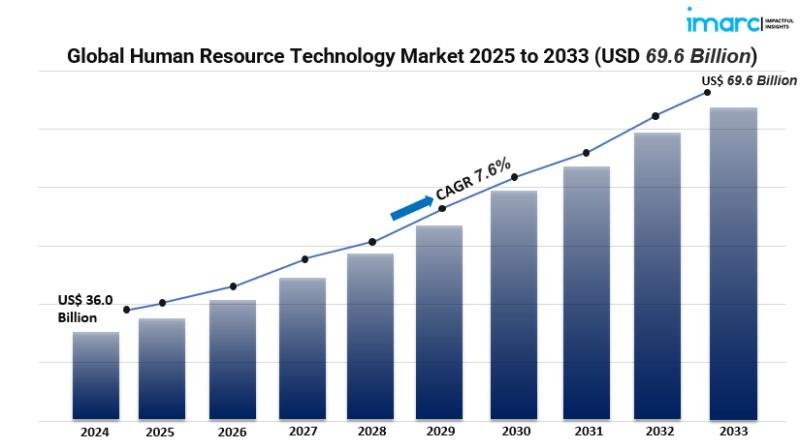
Market Overview
The global Human Resource Technology market is expanding rapidly as organizations streamline their HR operations through digital tools. Valued at USD 36.0 billion in 2024, the sector is forecast to nearly double-reaching USD 69.6 billion by 2033 at a 7.6 % CAGR. Key drivers include accelerated digital adoption, remote-work enablement, data-driven insights, and HR automation .
Study Assumption Years
• BASE YEAR: 2024
• HISTORICAL YEAR: 2019-2024
• FORECAST YEAR: 2025-2033
Human Resource Technology Market Key Takeaways
• Market scale & growth: From USD 36.0 B in 2024 to USD 69.6 B by 2033 at a 7.6 % CAGR
• Regional leader: North America dominates with 59.9 % share thanks to strong vendor presence and digital uptake
• Top segments: Talent management, payroll, performance/workforce management, recruitment, and others
• Technology drivers: AI, automation, cloud, analytics, and mobile/SaaS are reshaping HR workflows
• COVID 19 impact: Hybrid work models elevated demand for virtual onboarding, remote performance tracking, and cloud payroll
• Enterprise focus: Employee experience, compliance, and operational efficiency across industries propel adoption
Market Growth Factors
1. Technological Innovation & Automation
HR tech is undergoing a remarkable transformation thanks to advancements in AI, machine learning, and cloud computing, which are reshaping how HR operates. With tools like automated resume parsing, chatbots, and analytics platforms, the recruitment process is faster, performance tracking is more effective, and administrative tasks are streamlined. Digital solutions-ranging from cloud-based HCM systems to mobile applications-provide valuable data insights that empower organizations to make strategic decisions in real time. This evolution enhances efficiency, reduces errors, and fosters a more adaptable HR framework.
2. Rise of Remote Work & Employee Experience Focus
The rise of hybrid workplaces has significantly changed the landscape of HR needs. Companies are now turning to virtual onboarding, cloud-based time tracking, and remote collaboration tools to meet these demands. Moreover, a strong focus on employee experience-through personalized learning, ongoing feedback, and engagement platforms-has led to higher satisfaction and retention rates. HR technology plays a crucial role in bridging the gaps in employee engagement, ensuring that even remote teams remain connected and productive.
3. Data Driven Decision Making & Compliance
As labor laws and regulations become increasingly complex, particularly in North America and Europe, having the right HR tools is vital for compliance. Analytics and reporting features provide insights into issues like compensation fairness, attrition risks, talent shortages, and overall workforce productivity. These platforms streamline compliance processes, reduce the likelihood of errors, and aid in strategic planning. The ability to align HR management with legal standards and business goals is a key driver behind the growing adoption of technology in this field.
Request for a sample copy of this report: https://www.imarcgroup.com/human-resource-technology-market/requestsample
Market Segmentation
By Application:
• Talent Management: Tools for recruitment, development, performance, and succession
• Payroll Management
• Performance Management
• Workforce Management
• Recruitment
• Others
By Type:
• Inhouse
• Outsourced
By End Use Industry:
• TTH (Travel, Transportation, Hospitality)
• Public Sector
• Health Care
• Information Technology
• BFSI (Banking, Financial Services, Insurance)
• Others
By Company Size:
• Less than 1k Employees
• 1k-5k Employees
• Greater than 5k Employees
Breakup by Region:
• North America (United States, Canada)
• Asia Pacific (China, Japan, India, South Korea, Australia, Indonesia, Others)
• Europe (Germany, France, United Kingdom, Italy, Spain, Russia, Others)
• Latin America (Brazil, Mexico, Others)
• Middle East and Africa
Regional Insights
North America is leading the charge in the HR tech market, boasting nearly a 60% share in 2024. This dominance is fueled by a strong digital infrastructure, a thriving ecosystem of vendors, and the swift adoption of AI, analytics, and remote work tools. Companies are putting a premium on employee experience, regulatory compliance, and data security, which only strengthens the region’s position at the forefront.
Recent Developments & News
Top vendors are introducing tailored AI features and tools to enhance their offerings. For instance, Oracle rolled out AI-powered upgrades in Oracle Cloud HCM in September 2024, making talent and performance management smarter than ever. The pandemic has accelerated the growth of hybrid work solutions-think virtual onboarding, cloud payroll, and workforce analytics-transforming HR strategies on a global scale. Across various regions, investments are zeroing in on smooth digital transitions, empowering employees, and leveraging predictive analytics for insights-all of which point to a future where HR is not just strategic but also more people-focused and data-driven.
Key Players
• ADP Inc
• Cornerstone OnDemand, Inc.
• Dayforce, Inc.
• Infor
• Microsoft
• Oracle Corporation
• Paycom Payroll LLC
• Paylocity Holding Corporation
• SAP SE
• Sumtotal Systems, LLC
• UKG Inc.
• Workday Inc.
Ask Analyst for Customization: https://www.imarcgroup.com/request?type=report&id=1798&flag=C
If you require any specific information that is not covered currently within the scope of the report, we will provide the same as a part of the customization.
Contact Us:
IMARC Group
134 N 4th St. Brooklyn, NY 11249, USA
Email: [email protected]
Tel No: +1-631-791-1145
About Us:
IMARC Group is a global management consulting firm that helps the world’s most ambitious changemakers to create a lasting impact. The company provides a comprehensive suite of market entry and expansion services. IMARC offerings include a thorough market assessment, feasibility studies, company incorporation assistance, factory setup support, regulatory approvals and licensing navigation, branding, marketing and sales strategies, competitive landscape, and benchmarking analyses, pricing and cost research, and procurement research.
This release was published on openPR.



